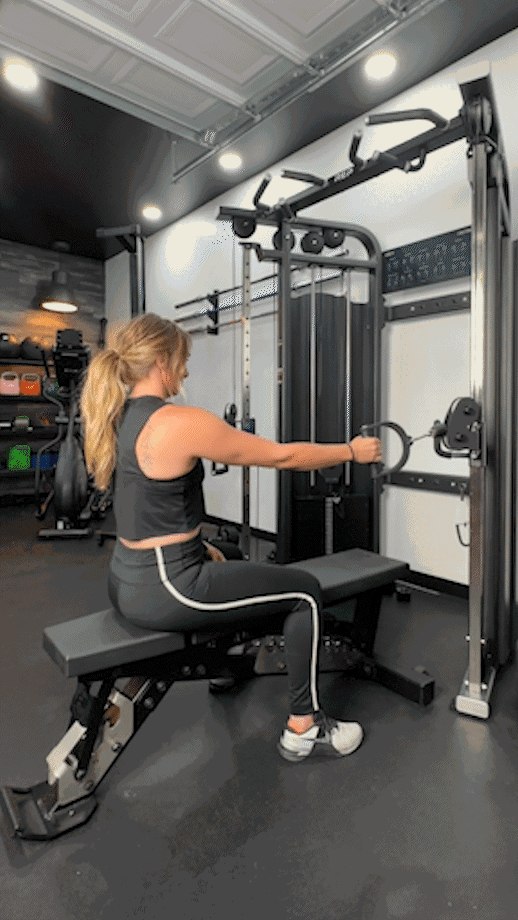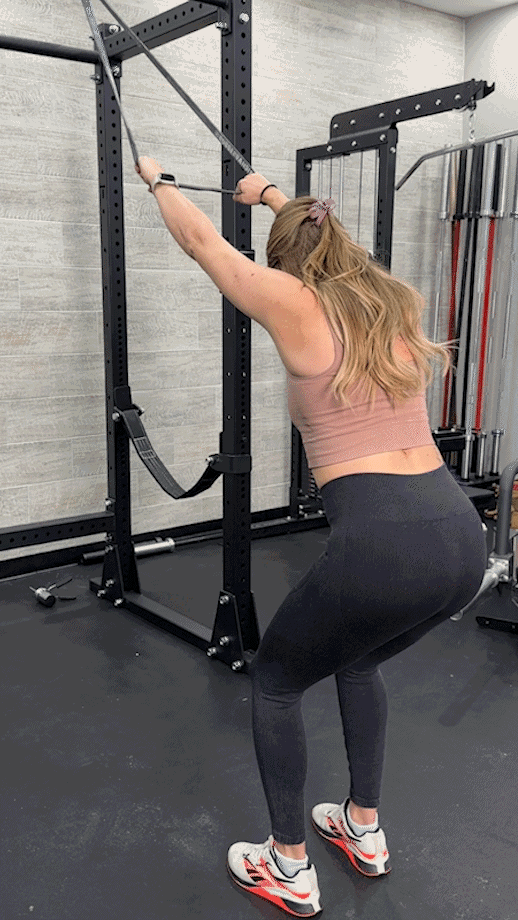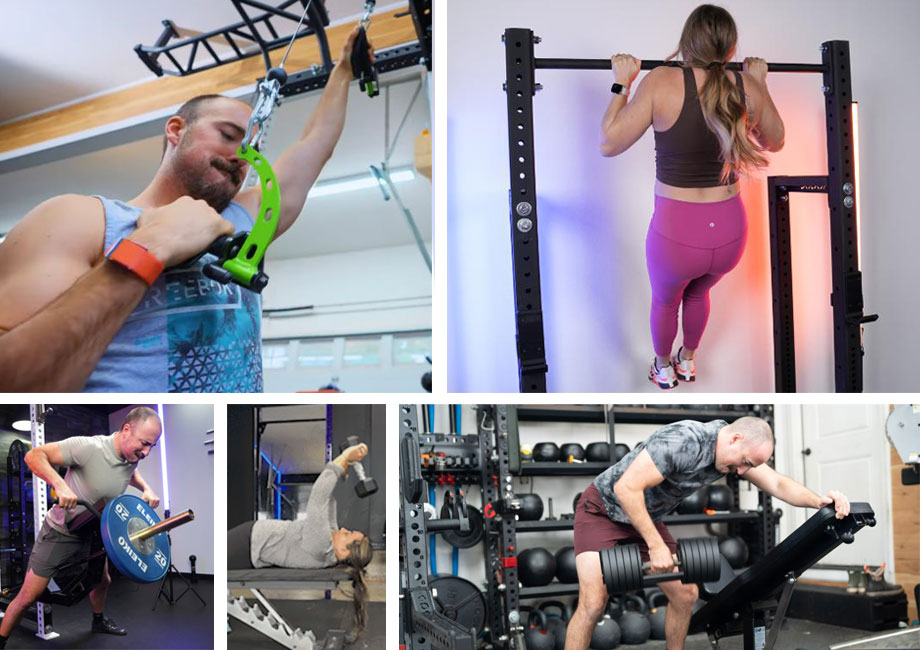Few gym experiences rival the exhilaration of a back workout, especially when utilizing the best lat pulldown machines to achieve that coveted pump. The latissimus dorsi muscles, aka the “lats,” represent one of the body’s largest and most complex muscle groups, extending from the upper to lower back regions and comprising multi-directional muscle fibers. But what happens when you hit the gym for your back session and find the lat pulldown machine busy, perhaps even broken? What if you need to squeeze in an at-home workout or simply want to switch up your routine? In these moments, versatility becomes essential.
RELATED: Pulldown Exercise
Lat pulldown machines are rare in the sports performance facilities where I coach, and in most home gyms. That’s why when my athletes and clients aim to build a bigger back, or I find myself training from home, I rely on these 10 best lat pulldown alternatives. They’re not only functional and require minimal equipment but also target the back from multiple angles, effectively engaging all the muscle fibers of the lats.
Give a few of these back exercises a try next time you hit the gym.
10 Best Lat Pulldown Alternatives
- Dumbbell Pullover
- Straight-Arm Pulldown
- Single-Arm Cable Pulldown
- Pull-Up
- Single-Arm Cable Row
- Resistance Band Pulldown
- One-Arm Dumbbell Row
- T-Bar Row
- Inverted Row
- Landmine Row
Dumbbell Pullover
Muscles worked: Latissimus dorsi (lats), pectoralis major (pecs), triceps brachii, deltoids (shoulders), serratus anterior
Benefits: The dumbbell pullover works the lats through a long range of motion and places them in a deeply stretched position, which studies show is imperative for muscle growth. An April 2012 study in the European Journal of Applied Physiology1, researchers found that, “training exclusively with eccentric (lengthening) contractions can result in greater muscular adaptations than training with concentric (shortening) contractions.” Moreover, it enhances shoulder mobility by stretching the lats and triceps, which is crucial for overhead movements. The set-up position engages your stabilizer muscles, such as the anterior core, upper back/shoulder blades, and glutes, building strength for better muscle function and performance.
How to do it:
- Position your upper back and shoulder blades on a flat bench.
- Hold a dumbbell with both hands positioned above your head.
- Keep a straight line from your shoulders to your knees with a slight bend in your elbows.
- Lower the dumbbell behind your head, feeling a stretch in your lats.
- Return the dumbbell to the starting position with control.
- Repeat for the desired number of sets and reps.

Modifications
- Dial it back: The dead bug pullover is a regression, reducing your range of motion and making core stabilization easier.
- Make it harder: Intensify the movement using a kettlebell because it shifts the load away from your working muscle group due to the grip. Or, try incorporating tempo training and pauses. Another option is to give an incline cable pulldown a go.
Straight-Arm Pulldown
Muscles worked: Lats, teres major, chest, and delts
Benefits: Also called a lat sweep, you can perform the straight-arm pulldown with a cable machine or resistance bands. This alternative is about as close to an isolation exercise as you’ll get for your lats, as it minimizes involvement from other muscle groups. Allow your your body to lean forward during the eccentric (lengthening) portion of the movement, which is shown to increase muscle growth2 by inducing a gnarly stretch of the lats.
How to do it:
- Use a straight-bar attachment on a lat pulldown machine or cable machine.
- Grab the bar with an overhand grip (palms facing downward).
- With your arms straight, engage your lats to push the bar downward.
- Pause briefly at the bottom, squeezing your lat muscles.
- Slowly return the bar to the starting position with control.
- Repeat for the desired number of sets and reps.

Modifications
- Dial it back: Opt for a resistance band variation of the straight-arm pulldown to lower your intensity (or if you don’t have access to a cable machine).
- Make it harder: Perform the exercise unilaterally (with a single arm), which increases the focus on each of your lats individually. Starting each repetition with a higher angle can enhance the full range of motion and improve your time under tension.
RELATED: Best Resistance Bands
Single-Arm Cable Pulldown
Muscles worked: Lats, obliques and transverse abdominis, delts, biceps, and forearms
Benefits: The single-arm cable pulldown enhances unilateral strength and builds muscle, focusing on the vertical muscle fibers of the lat. Additionally, it activates the core for anti-rotational stability and enhances thoracic mobility. Adjusting your torso angle allows you to vary the exercise’s focus, whether maintaining a more vertical posture or leaning slightly back for alternative muscle engagement.
How to do it:
- Attach a D-handle to the cable machine with the pulley set to the highest setting.
- Stand facing the machine and grasp the handle with your left hand using a palms-down grip.
- Take a few steps back from the machine, square your stance, and hinge forward so your torso is between 45 degrees or parallel to the floor (whichever is more comfortable). You should feel a stretch in your lats.
- Pull the handle down toward your hip in a controlled motion, focusing on contracting your lat muscle.
- Pause briefly at the bottom of the movement, then slowly return to the starting position. After completing all reps on your left side, switch to your right arm and repeat the set.

Modifications
- Dial it back: Use a seated position or stabilize your torso by holding onto the machine.
- Make it harder: Incorporate different stance positions such as standing, split stance, half-kneeling, or tall-kneeling to add variety and target various muscle groups. Additionally, utilizing eccentric movements, characterized by slow returns, can increase intensity and muscle engagement without increasing weight.
Pull-Up
Muscles worked: Lats, trapezius (upper and middle fibers), rhomboids, erector spinae, delts (posterior), biceps brachii, brachialis, brachioradialis, and forearms
Benefits: Few bodyweight exercises match the effectiveness of the pull-up. Maneuvering one’s bodyweight through a complete range of motion epitomizes functional strength. This time-tested compound exercise offers adaptability and versatility, catering precisely to individual needs and objectives, and trains the entire length of your lats, from top to bottom.
How to do it:
- Grab a pull-up bar with an overhand grip, shoulder-width apart, and ensure your arms are straight.
- Pull yourself up until your chest is at the bar by squeezing your lats, upper back, and arms.
- Lower yourself with control, keeping your lats, upper back, and arms tight until your arms are straight.
- Repeat for reps.

Modifications
- Dial it back: Performing pull-ups standing on a resistance band or an assisted pull-up machine is a straightforward modification for an assisted pull-up. Alternatively, you can opt for chin-ups and neutral-grip pull-ups, which engage your biceps and generally allow you to eke out a few more reps.
- Make it harder: Eccentrics (slow lowerings), tempos, pauses, or loading with weight can increase the intensity of your pull-ups.
Single-Arm Cable Row
Muscles worked: Lats, rhomboids, traps, posterior delts, biceps brachii, and forearms
Benefits: When combined with adjustable cable heights and customizable grip options, the single-arm cable row offers a personalized range of motion, optimizing your back strength and stability. The constant tension created by the cable row ensures muscle engagement throughout, maximizing the benefits of unilateral exercises and fostering balanced muscle development. Depending on the variation, the single-arm cable row can add a touch of rotational core work and t-spine mobility.
How to do it:
- Set the cable machine pulley to chest height and attach a handle.
- Position an adjustable bench to 90-degrees, taking a seated position and bracing against the back rest.
- Squeeze your shoulder blades together as you pull the handle toward the right side of your body, keeping your right elbow close to your torso.
- Pause briefly, then slowly return the pulley to the starting position.
- Complete the desired number of reps, and then switch to your left side and repeat the set.
RELATED: Best Back Exercises

Modifications
- Dial it back: Lower the weight, or try performing the exercise with a resistance band wrapped around a squat rack or attached to a door.
- Make it harder: Incorporate different stances, such as standing, split stance, half-kneeling, or tall-kneeling, to add variety and target various muscle groups. Additionally, utilizing eccentric movements, characterized by slow returns, can increase intensity and muscle engagement without increasing weight.
Resistance Band Pulldown
Muscles worked: Lats, teres major, rhomboids, traps, posterior delts, biceps brachii, and forearms
Benefits: A resistance band pulldown replicates the motion of a standard lat pulldown, offering similar advantages while being convenient for home workouts. Additionally, it enables you to focus on the concentric (shortening) muscle action, as the resistance band assists with the exercise’s eccentric (lengthening) phase.
How to do it:
- Anchor a resistance band overhead using a sturdy structure like a power rack or pull-up bar.
- Position yourself directly beneath the anchor point, either sitting or kneeling.
- Grasp the resistance band handles with an overhand grip, slightly wider than shoulder-width apart.
- Pull the handles down toward your chest, keeping your elbows close to your body and shoulder blades squeezed together.
- Pause briefly at the bottom, then return to the starting position with control.
- Repeat for the desired number of repetitions, maintaining proper form and engaging your lat muscles.

Modifications
- Dial it back: Use a lighter resistance band.
- Make it harder: Single-arm variations increase the intensity by engaging the core to stabilize the torso against rotation. To further challenge stability, try incorporating different base stance positions such as half-kneeling, tall-kneeling, or seated positions. Another option is to keep your hands wider when rowing, mimicking a wide-grip lat pulldown.
Single-Arm Dumbbell Row
Muscles worked: Lats, rhomboids, traps, posterior delts, biceps brachii, and forearms
Benefits: One-arm dumbbell rows (or single-arm dumbbell rows as they’re commonly called) offer a potent opportunity to boost unilateral strength, rectify muscle imbalances, and amplify muscle building as a lat-focused exercise. With many variations available, including single-hand support, bench support with knee and hand, bent-over alternating, and bird-dog rows, there’s ample room to diversify your routine and optimize results. Don’t limit yourself to just one variation.
How to do it:
- Stand beside a flat bench with your feet shoulder-width apart and knees slightly bent.
- Bend at your hips and knees and pick up the dumbbell with one hand.
- Place your opposite knee and hand on the bench for support, keeping your back parallel to the ground.
- Pull the dumbbell toward your hip, keeping your elbow close to your body and squeezing your shoulder blades together.
- Lower the dumbbell back down with control.
- Repeat for the desired number of repetitions, then switch sides.
Expert tip: Cue each rep with a deliberate “big reach” toward the floor, followed by a powerful “big pull” during the row. This technique not only facilitates a fuller range of motion but also enhances your awareness of the lat muscles as they lengthen and contract with each movement, optimizing the effectiveness of every rep.

Modifications
- Dial it back: Opting for a resistance band instead of dumbbells can offer an easier variation.
- Make it harder: Integrate tempos and pauses into your routine, or challenge your core stability with variations such as bent-over one-arm rows using various positions, dead-stop rows, or bird-dog rows.
T-Bar Row
Muscles worked: Lats, teres major, rhomboids, traps, posterior delts, biceps brachii, forearms, and erector spinae
Benefits: T-bar rows offer a supportive setup, allowing you to isolate your lats and target your mid-back muscles. Due to the nature of the movement, I often program the T-bar row to target the lower traps and rhomboids, paired with training the medial (closer to your midline) lats.
How to do it:
- Straddle the T-bar (or landmine) machine with your feet shoulder-width apart.
- Bend at your hips and grip the bar or handles with an overhand grip.
- Pull the bar toward your lower chest, engaging your lats and squeezing your shoulder blades together.
- Pause briefly at the top, then lower the bar back down.
- Repeat for desired sets and reps.

Modifications
- Dial it back: Decreasing the range of motion using a lower bench or platform that sits closer to the bar can help lower the intensity of the T-bar row.
- Make it harder: Besides increasing the weight, using a wider grip, increasing your range of motion, or slowing down your reps are effective ways to make the T-bar row harder.
Inverted Row
Muscles worked: Lats, traps, rhomboids, posterior delts, biceps brachii, brachialis, brachioradialis, and forearms.
Benefits: Inverted rows introduce bodyweight training to your back workouts and serve as a potent regression for pull-ups. While pull-ups primarily target the vertical fibers of your lats, inverted rows uniquely engage the horizontal fibers, ensuring a well-rounded lat-focused exercise option. Plus, they’re not just about the back—inverted rows sneak in a little extra ab work, and with a wider grip, you can target the rear delts.
How to do it:
- Set up a bar at waist height in a power rack or smith machine
- Grip it with your hands shoulder-width apart, palms facing away from your body.
- Hang beneath the bar, keeping your body straight from head to heels.
- Pull your chest toward the bar by squeezing your shoulder blades together, keeping your elbows close to your body.
- Pause at the top, then lower back down with control.
- Repeat for desired reps, focusing on maintaining your form throughout.

Modifications
- Dial it back: Raise the height of the bar during setup to make the inverted row easier.
- Make it harder: Lowering the height of the bar during setup can increase the intensity of the inverted row. You can also enhance the difficulty by incorporating tempos and pauses or adding a weighted vest.
RELATED: Row Exercises
Single-Arm Landmine Row
Muscles worked: Lats, traps, rhomboids, posterior delts, biceps brachii, brachialis, brachioradialis, and forearms.
Benefits: Landmine rows can provide a unique lat-focused challenge by offering a distinct angle of resistance, targeting the lateral aspect of your lats, and enhancing unilateral strength, which is crucial for developing your back. Additionally, the barbell sleeve functions as a “fat grip,” challenging your forearm strength.
How to Do it:
- Position a barbell in a landmine attachment or anchor it securely in a corner.
- Stand perpendicular to the barbell with one foot in front of the other, holding the barbell with the hand opposite your forward foot.
- Keep your back straight and hinge at the hips slightly.
- Pull the barbell towards your hip, keeping your elbow close to your body and squeezing your shoulder blade.
- Pause briefly at the top of the movement, then lower the barbell back down with control.
- Repeat for reps, then switch sides and repeat the set.
Modifications
- Dial it back: Opt for a shorter barbell to simplify landmine rows. This adjustment reduces the lever arm distance and the range of motion required for the weight to move, making the exercise more manageable.
- Make it harder: A few ways to make a landmine row harder are to work from a deficit, which increases the range of motion, attach a fat grip to the barbell to challenge your forearm strength, or utilize tempos and pauses.
Sample Lat Pulldown Alternative Workouts
Below, I’ve prepared a few sample workouts to incorporate into your training routine if you cannot utilize the lat pulldown machine or want to diversify your lat workouts. I’ve designed these workouts to target vertical and horizontal patterns, ensuring every muscle fiber receives attention and care.
Lat Workout for Beginners
Beginners want to prioritize simple and progressively challenging movements to master techniques and build foundational strength and size. This beginner-level lat pulldown alternative workout emphasizes simplicity to establish a solid foundation.
RELATED: Workout Schedule for Beginners
Compound strength exercises develop base strength; unilateral movements amplify hypertrophy and establish muscular balance. The workout also provides exposure to varying rep schemes by moving from strength to hypertrophy ranges3, an excellent benefit for novice lifters.
Begin with light weights or use your body weight, prioritizing proper form to lay the groundwork for advancing to more complex exercises as you improve.

Warm-up: Perform 1 to 2 rounds
- Cat-cow: 10 reps
- Incline I-Y-T: 5 reps, each position
- Band pull-apart:10 reps
- Bird dog holds: 30 seconds, each side
- Plank with shoulder taps: 10 reps, each side
| Exercise | Sets | Reps |
| Chin-up (bodyweight or band-assisted) | 3 | 5-8 |
| Single-arm landmine row or T-bar row | 3 | 8-12, each side |
| Resistance band pulldown | 3 | 8-12 |
| Seated cable row | 3 | 12-15 |
Equipment needed: Pull-up bar, barbell, landmine attachment, resistance bands, cable machine
Lat Workout for Strength
Lat-focused strength workouts begin with compound exercises that offer significant benefits, emphasizing the recruitment of large muscle groups to cultivate a striking V-taper. The lat workout below uses a balanced approach of alternating between vertical and horizontal pulling movements and concludes with unilateral exercises that maximize back strength and symmetry.

Warm-up: Perform 2 to 3 rounds
- Standing t-spine rotation: 10 reps, each side
- Quadruped scapula circles: 10 reps
- Band or cable face pull: 10 reps
- Band or cable straight-arm pulldown:10 reps
| Exercise | Sets | Reps |
| Pull-up | 4 | 6-10 |
| T-bar row | 3 | 6-10 |
| Single-arm cable pulldown | 3 | 8-12, each side |
| One-arm dumbbell row | 3 | 8-12, each side |
Equipment needed: A pull-up bar, barbell with a T-bar attachment or T-bar machine, cable machine, resistance bands, or a pair of the best dumbbells.
Lat Workout for Hypertrophy
This lat-focused workout aims to build muscle through bodybuilding-esque volume and using higher-rep sets. The routine incorporates bilateral and unilateral compound exercises, ensuring a potent approach to stimulating muscle size development.
Given the emphasis on muscle fatigue in hypertrophy-focused workouts, starting with moderate weights is recommended. Strive to reach each set’s higher end of the rep ranges before considering weight increases and keep your rest periods between 60 and 90 seconds.

Warm-up: Perform 2 to 3 rounds
- Cat-cow: 10 reps
- Dead hang: 20 sec.
- Scapular pull-up: 10 reps
- Band pull-apart:10 reps
- Plank with shoulder tap: 10 reps, each side
| Exercise | Sets | Reps |
| Inverted row | 4 | 8-12 |
| Dumbbell pullover | 4 | 8-12 |
| Single-arm cable row | 3 | 12-15 |
| Straight-arm pulldown | 3 | 12-15 |
Equipment needed: Barbell and a squat rack or a Smith machine, dumbbell, cable machine
RELATED: Best Cable Machine for Home Gym
Anatomy of the Back/Lats
The latissimus dorsi, or lats, boasts a unique anatomical structure spanning a large portion of the back, from the lower spine to the upper arm. Its broad, fan-like shape contributes to the coveted V-shape physique and emphasizes its crucial role in various upper body movements such as pulling, rowing, and lifting.
Understanding the lats’ expansive reach and role and how it interacts with the surrounding back muscles is crucial for crafting a training regimen to optimize back strength, stability, and aesthetics.

- Latissimus Dorsi4: Primarily functions in shoulder extension, pulling the upper arm down and back toward the body. It also contributes to shoulder adduction, bringing the upper arm toward the body’s midline, internal rotation, stabilizing the torso during pulling movements, and aiding in scapular stabilization against the thoracic cage.
- Teres Major5: Aids in internal rotation of the humerus (upper arm) and can extend the arm from a flexed position. Assists the latissimus dorsi in shoulder adduction and extension, contributing to movements like pulling the upper arm downward and backward toward the body.
- Rhomboid6: Primarily responsible for scapular retraction, pulling the shoulder blades together towards the spine (think of band pull-aparts). This action aids in maintaining proper posture and stabilizing the scapula during various upper-body movements.
- Trapezius7: Its upper, middle, and lower fibers are crucial for shoulder girdle movements. It assists in shoulder elevation, retraction, and depression, contributing to shrugging, pulling the shoulders back, and lowering them down.
- Levator Scapulae8: Aids in elevating the scapula by helping lift your shoulders toward your ears. It also assists in rotating the scapula downward, facilitating movements like shoulder shrugs, and maintaining proper shoulder positioning during various upper-body exercises.
Benefits of Lat Pulldown Alternatives
Your lats are more than just for show. Crafting a strategic training regimen that integrates the advantages of lat pulldown alternative exercises will elevate your strength and size and fortify your shoulder health and function. These exercises are straightforward to progress, ensuring continuous improvement in your fitness journey.
Helps Enhance Strength and Size
In an October 2016 study in the Journal of Strength and Conditioning Research9, researchers found that compound exercises that target the back, such as variations of rows, pull-ups, and pull-downs, can effectively stimulate muscle hypertrophy and strength in your lats.
RELATED: Bent-Over Row Variations
Beyond compound exercises, it’s essential to incorporate various movements to stimulate muscle growth and prevent plateaus in your training progress. Integrating lat pulldown alternatives into your regimen diversifies your workouts and ensures continuous progress toward your fitness goals.
Helps Improve Shoulder Health and Function
The latissimus dorsi contributes to movements like shoulder extension and adduction and aids in stabilizing the shoulder joint10 during various upper-body exercises. Solid and well-developed lats help maintain proper shoulder alignment, reducing the risk of injuries such as impingement or rotator cuff strains.
RELATED: Upper-Body Workout At Home

Training the lats can improve overall posture, alleviating shoulder and upper back tension. Incorporating exercises that strengthen and mobilize the lats into your workout routine can help enhance shoulder stability, mobility, and overall function, promoting optimal performance and injury prevention.
Gives You Variety
Not all gyms have sufficient lat pulldown machines, or their availability is limited. Knowing a selection of the best lat pulldown alternatives offers you the flexibility to maintain your back-day routine and continue crushing your workouts. Plus, they allow you to toss fresh exercises into your routine if you want to mix things up.
Easy to Progress
The best lat pulldown alternatives are straightforward to execute, allowing for easy progression in intensity and volume. Adjusting grip variations (overhand-grip, underhand-grip, or close-grip) and handle attachments targets different muscle groups and adds specificity to your training. Similarly, incorporating tempos and pauses helps enhance your strength and size development.
Continuous progression through these lat pulldown variations boosts your confidence and motivation and keeps your workouts engaging.
Lat Pulldown Alternatives: Final Thoughts
If it’s back day and the lat pulldown machine is broken or busy, or you’re looking for a fresh change in your workouts, lat pulldown alternatives can offer the same benefits while developing the chiseled V-taper or cobra back you’re after.
Let’s tie it all together:
- The lats are one of the largest muscle groups in the human body, composed of vertical and horizontal muscle fibers.
- The lats work with smaller muscle groups to facilitate the strength, movement, and stability of your scapula, shoulders, and upper back.
- Lat pulldown alternatives enhance the strength and size of your back muscles, offering versatile training options that you can progress.
- The best back workouts should incorporate bilateral and unilateral exercises to target your lats through diverse movement patterns.
RELATED: Back and Biceps Workout
Lat Pulldown Alternatives: FAQs
What is the home equivalent of a lat pulldown?
If you have a pull-up bar in your home gym, you can achieve the home equivalent of a lat pulldown exercise through pull-up and chin-up variations. These exercises target the vertical muscle fibers in your lats, replicating the action of a lat pulldown machine and emphasizing vertical pulling actions.
Alternatively, I love using a heavy resistance band anchored to a pull-up bar, mounted squat rack, or a door that can simulate the resistance and motion of a lat pulldown. Experiment with seated, tall, or half-kneeling positions to maintain variety and challenge your workouts.
RELATED: DIY Lat Pulldown
How can I train my lats without a machine?
There are several effective ways to train your lats using free weights, like the best adjustable dumbbells, the best budget barbell, or resistance bands.
Here are some recommended back exercises that you can incorporate into your home or gym workouts:
-Dumbbell single-arm row
-Dumbbell bent-over row
-Barbell row
-Landmine row
-Resistance band row
-Resistance band pulldown
-Inverted row
If you’re weightlifting at home, here’s a quick set and rep guide:
-Strength: 3 sets of 6 to 8 reps
-Hypertrophy: 3 sets of 8 to 15 reps
-Muscle endurance: 3 sets of 15 to 20 reps
Can pull-ups replace lat pulldown?
Pull-ups and lat pulldowns are potent for recruiting the biceps, core, and other muscles in your upper back, including the rhomboids, traps, teres major and minor, and more. Due to this, they can be interchangeable—to a point. The main difference is pull-ups require you to move your body weight up against gravity to reach the bar, and lat pulldowns require you to pull the bar down toward your chest.
They’re both exceptional compound exercises, so I recommend training them on opposing back-day workouts or focusing on one movement for a cycle, then switching movements for the next cycle.
RELATED: Lat Pulldown Vs. Pull-up
References
- Moore, Daniel R et al. “Similar increases in muscle size and strength in young men after training with maximal shortening or lengthening contractions when matched for total work.” European journal of applied physiology vol. 112,4 (2012): 1587-92. doi:10.1007/s00421-011-2078-x
- Wolf, Milo & Androulakis-Korakakis, Patroklos & Fisher, James & Schoenfeld, Brad & Steele, James & Wolf, M & Steele,. (2023). Partial Vs Full Range of Motion Resistance Training: A Systematic Review and Meta-Analysis. 3. 10.47206/ijsc.v3i1.182.
- Schoenfeld, Brad J et al. “Loading Recommendations for Muscle Strength, Hypertrophy, and Local Endurance: A Re-Examination of the Repetition Continuum.” Sports (Basel, Switzerland) vol. 9,2 32. 22 Feb. 2021, doi:10.3390/sports9020032
- Kenhub. Latissimus Dorsi. Accessed April 9, 2024. Available from: https://www.kenhub.com/en/library/anatomy/latissimus-dorsi-muscle
- Kenhub. Teres Major. Accessed April 9, 2024. Available from: https://www.kenhub.com/en/library/anatomy/teres-major-muscle
- Kenhub. Rhomboid. Accessed April 9, 2024. Available from: https://www.kenhub.com/en/library/anatomy/rhomboid-muscles
- Kenhub. Trapezius. Accessed April 9, 2024. Available from: https://www.kenhub.com/en/library/anatomy/trapezius-muscle
- Kenhub. Levator Scapulae. Accessed April 9, 2024. Available from: https://www.kenhub.com/en/library/anatomy/levator-scapulae-muscle
- Schoenfeld, Brad J., et al. “Effects of Low- vs. High-Load Resistance Training on Muscle Strength and Hypertrophy in Well-Trained Men.” The Journal of Strength & Conditioning Research, vol. 31, no. 12, 2016, pp. 3508-3523.
- Jeno SH, Varacallo M. “Anatomy, Back, Latissimus Dorsi.” StatPearls, updated March 5, 2023, StatPearls Publishing, January 2024, https://www.ncbi.nlm.nih.gov/books/NBK448120/.







